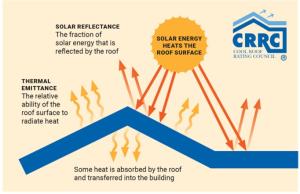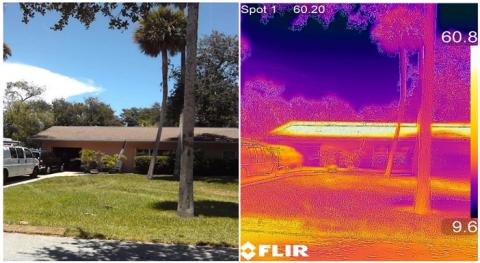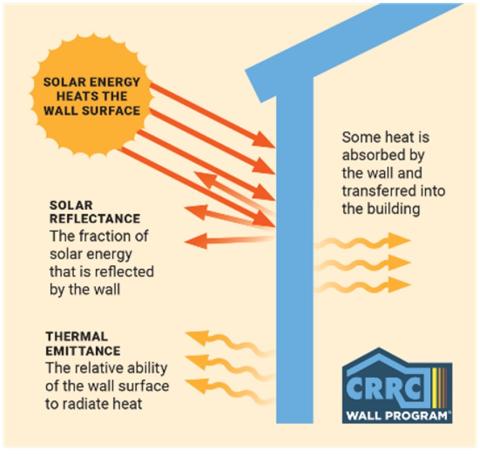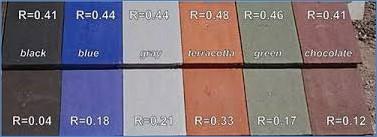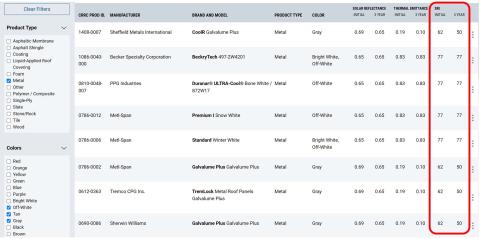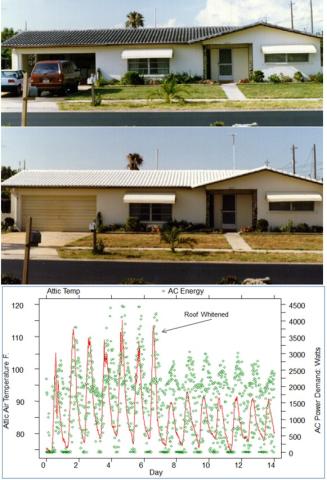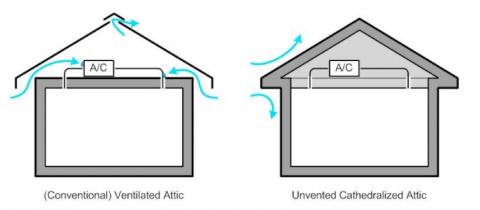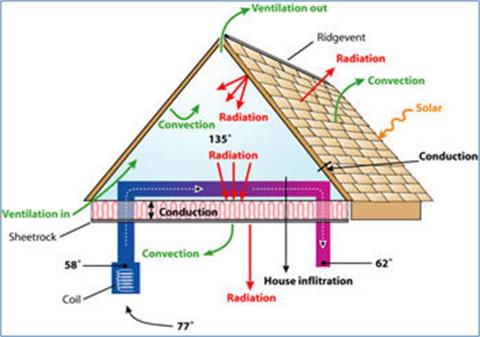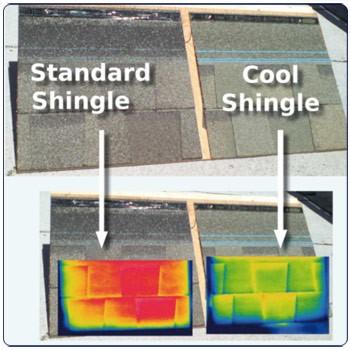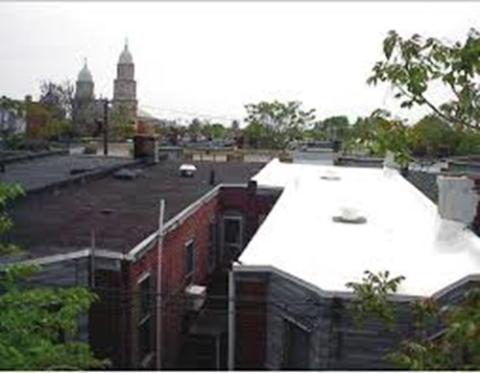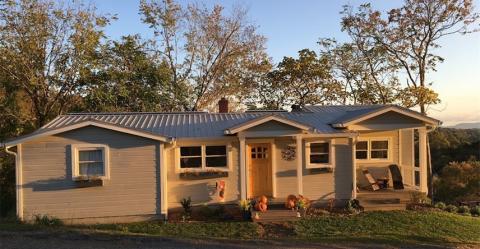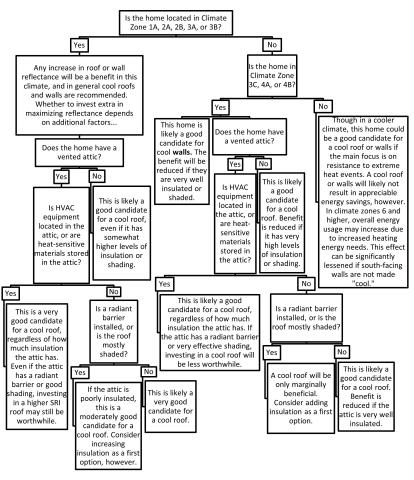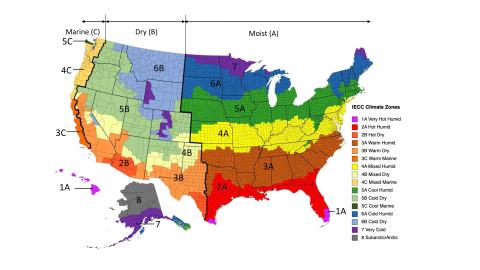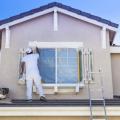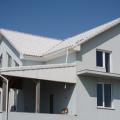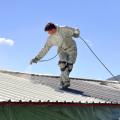Scope
To reduce air-conditioning usage in summer and to increase the "hours of safety" provided by a home during extreme heat, select “cool” roofing and wall cladding materials and colors when installing roofing or siding for new or existing homes. Select cool paint colors when painting exterior walls.
- Determine the IECC climate zone where the home is located (see Climate tab).
- Assess how appropriate the home is for a cool roof and/or walls based on climate zone, attic type, and other home characteristics.
- Use the database of roofing and wall cladding materials and finishes published by the Cool Roof Rating Council to compare and select roofing and siding products based on their ability to maintain cool surface temperatures.
See the Compliance Tab for links to related codes and standards and voluntary federal energy-efficiency program requirements.
Description
A “cool” roof or wall simply refers to a roof or wall that uses a roofing material, siding material, paint, or coating that is designed to stay relatively cool when the sun is shining directly on it (Figure 1). The roof or wall surface literally stays cooler and reduces the amount of heat conducted into the building. This can help keep the living space cooler and at a more constant temperature even when the house does not have air conditioning (A/C). If a building has air conditioning, the equipment does not have to work as hard. Cool roofs and walls are installed to reduce cooling energy consumption, improve comfort, and as a disaster-resistance measure in response to the increasing frequency and intensity of extreme heat events . They are also installed in communities to help reduce the urban heat island effect.
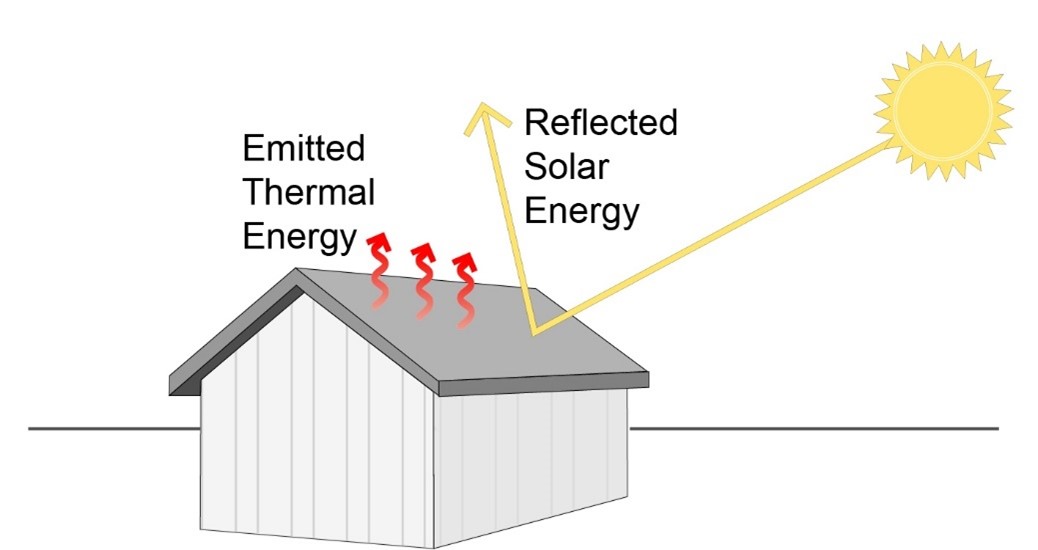
Conventional dark or medium-colored roofing and siding materials readily absorb heat from the sun and transmit that heat into the home (Figure 2). This heat gain results in higher cooling energy usage in air-conditioned homes, and results in higher interior temperatures and reduced comfort in homes without A/C. Cool roofs and walls can greatly reduce the amount of heat transferred into the home, improving comfort, energy efficiency, HVAC equipment longevity, and a home’s survivability during periods of extreme heat.
Although light-colored building surfaces have been used in hot climates since ancient times (Figure 3), significant improvements and adaptation to modern buildings is a more recent development. White colored surfaces tend to be most effective, but modern coatings improve performance and allow a variety of “cool” color options.
How Cool Surfaces Work
Cool roof and wall materials have two primary properties that help them stay cool: high solar reflectance and high thermal emittance (Figure 4).
Solar reflectance indicates how strongly a surface reflects sunlight (solar energy). Imagine wearing a white or a black T-shirt on a hot, sunny day. By wearing the white T-shirt you will remain cooler than if you wore a black T-shirt because it reflects more sunlight and absorbs less heat.
About half of the solar energy that strikes the surface of the earth is visible light and about half is heat (called near-infrared radiation). But all solar energy, whether visible light or non-visible infrared radiation, becomes thermal energy (heat) when it is absorbed by a surface such as a roof. Therefore, the ideal cool roof or wall would be very reflective to both visible light and near-infrared radiation. Light colors reflect visible light very well. This is why a white T-shirt stays cooler than a black T-shirt. However, color does not indicate how reflective a material is to the non-visible near-infrared radiation from the sun. Roofing products of any color can be made to reflect near-infrared radiation through the use of special transparent coatings. This means that cool roofs or exterior walls do not need to be white. There are many "cool color" products with coatings that are highly reflective in the near-infrared portion of the solar spectrum (Figure 5). They still absorb visible light, causing heat gain, but they do not heat up as much as they would without these coatings.
solar reflectance of a material is a measure of how much solar energy it reflects – both visible light and near-infrared radiation. Solar reflectance is measured on a scale of 0 to 1, where 1 is 100% reflective. Materials with higher solar reflectance values will stay cooler in the sunlight.
Thermal emittance is the second important property of cool roof and wall materials. When any material like a roof or wall heats up, some of its heat will move toward the interior and some will radiate outward to the sky or other objects. Thermal emittance is a measure of how much of the heat radiates away rather than staying in the material. Like solar reflectance, thermal emittance is measured on a scale of 0 to 1, where 1 is 100% emissive. Materials with higher thermal emittance values will stay cooler in the sunlight because they give off their heat more readily. Color is not directly related to thermal emittance: the color of a material cannot be used as an indicator of high or low thermal emittance.
Rating Cool Roofs and Walls
The Solar Reflectance Index (SRI) is a single value that accounts for both solar reflectance and thermal emittance, allowing one number to represent how cool a roofing product is compared to other products. SRI provides a simple way to compare the “coolness” of various roofing materials. SRI typically ranges from 0 to 100, though some materials can be higher or lower than this range. Higher values indicate a cooler surface. SRI was originally developed specifically for roofing products and is not used to rate cool walls. Currently (as of Feb. 2023), cool walls are best compared using solar reflectance and thermal emittance values.
SRIs can be calculated and reported as initial (new) values or as three-year aged values. Aged values, based on three years of natural weathering, are the industry standard and what many codes and standards require for compliance. The SRI of roofing products is calculated in accordance with ASTM E1980.
The Cool Roof Rating Council (CRRC) is a 501(c)(3) nonprofit organization that develops methods for evaluating and labeling roof and exterior wall products. The CRRC Rated Roof Products Directory is an extensive searchable database of roofing products that have undergone standard solar reflectance and thermal emittance testing. The directory lists rating data for more than 3,000 roof products including asphalt shingles, clay and concrete tiles, metal roofing, roof coatings, and single-ply membranes. This is an excellent resource to help find and compare roofing products. The CRRC Rated Wall Products Directory is a much newer database where exterior wall products can be compared based on solar reflectance and thermal emittance values.
Figure 6 is a screen shot of a search for metal roofing on the CRRC Rated Roof Products Directory. The search has been filtered to include only three color options (off-white, tan, and gray). The columns circled in red show the initial and 3-year aged SRI for each product. If solar reflectance and thermal emittance are known, but the SRI is not, this SRI calculator created by Lawrence Berkeley National Laboratory can be used to calculate the SRI of a roofing material.
When comparing and selecting roofing products, it is important to understand that there is no commonly accepted solar reflectance, thermal emittance, or SRI threshold for what counts as a cool roof and what does not. Several codes and voluntary programs have established minimum requirements, including the IECC (commercial buildings), ENERGY STAR, and the California Energy Commission. In most cases the requirements depend upon whether the roof is considered low-slope (less than or equal to 2:12 pitch) or steep slope (greater than 2:12 pitch).
Benefits of Cool Roofs and Walls
Cool roofs and walls are a proven technology for reducing heat gain to a building. In homes with air-conditioning, they can provide measurable energy savings, improved comfort, and reduced wear on air-conditioning equipment. In homes without air-conditioning, cool roofs and walls can result in lower inside temperatures and improved comfort in the summer. From a community perspective, cool surfaces have been shown to reduce the urban heat island effect, the well documented concept that areas with a high density of buildings and pavement get measurably hotter than more vegetated areas. Cool roofs and walls result in a lowering of ambient temperatures in the surrounding area.
Studies have shown that energy savings from cool roofs or walls can vary widely depending on climate and home characteristics, but the overall reduction in cooling energy is well-documented (Parker et al. 1998; Parker et al. 2020; Sonne et al. 2001; Parker et al. 2002). In a comprehensive simulation study of average new and existing homes across the United States, total HVAC savings of about 6% to 12% were shown for homes with relatively cool roofs and walls in warmer climate zones (Rosado and Levinson 2019). These savings values account for any increase in heating energy that would result from cool roofs or walls. The savings would be higher for homes with air handling units (AHU) and ductwork located in the attic, or for homes with lower amounts of attic or wall insulation. Figure 7 shows the results of a direct comparison study in Florida, where attic temperatures and air-conditioning usage were measured before and after a cool roof coating was installed (note that applying roof coatings can void roofing manufacturers’ warranties).
Oak Ridge National Laboratory has created the DOE Steep Slope Calculator to allow homeowners to estimate the energy cost savings potential of installing a cool roof. It requires simple inputs such as roof insulation value and the properties of the new cool roof.
Although roofs receive more solar energy than walls, cool walls can show equal or greater savings than cool roofs because walls usually have significantly less insulation than roofs or attics, and walls usually have more surface area than roofs. However, roofs are usually much more exposed to the sun than walls and walls received more benefit from the cooling effect of shade from landscaping, other buildings, and roof eaves.
Regardless of the amount of energy savings, cool roofs and walls can increase the "hours of safety" provided by a home during extreme heat events (Kaiyu et al. 2021). Extreme heat is the deadliest of all natural disasters and is predicted to increase in intensity and frequency. The benefit of cool roofs and walls to non-air-conditioned homes is clear (the interior of the home stays cooler and thus safer), but for air-conditioned homes the benefit is less obvious. Extreme heat taxes the electricity grid, increasing the likelihood of a power outage and loss of A/C. Extreme heat also makes A/C systems work harder, making failure more likely. Cool roofs and walls can ease the strain on the system and, if A/C is lost, can improve the occupants’ ability to survive a heat wave. They serve as a legitimate passive disaster-resistance measure that can provide energy savings year after year.
See the “Extreme Heat Overview” guide for more information on extreme heat, hours of safety, and the urban heat island effect.
Deciding Whether to Install Cool Roofs or Walls
The design phase of new home construction is the ideal time to implement cool roof and wall strategies. For existing homes, the most cost-effective times are when the home needs to be re-roofed, re-sided, or re-painted.
Several factors should be considered when deciding whether a cool roof or cool walls are appropriate and cost effective for a specific home. The first consideration is climate. Cool roofs and walls will reduce solar heat gain in both summer and winter, so wintertime heating requirements can be expected to increase. This energy increase counteracts the savings in air-conditioning, making cool surface technology less appropriate in colder climates. See the Climate tab for a map of IECC 2021 climate zones in the United States. Studies indicate that, in terms of energy savings, cool roofs and cool walls are clearly appropriate for new and existing homes in Climate Zones 1A up to 3A and 3B. In climate zones 3C, 4A, and 4B, the energy saving benefits are generally marginal for new homes, but worthwhile for older homes with less insulation. For climate zones 4C and above, the overall energy benefit of cool roofs and walls is generally small. The effect can actually be negative overall in the colder climates, due to increased heating (Rosado and Levinson 2019). For resistance to extreme heat, however, cool roofs and walls could be beneficial in all climates (heat waves can occur in even the coldest U.S. climates).
A second factor to be considered is the amount of insulation in a roof, attic, or wall. The better insulated a roof, attic, or wall assembly is, the less influenced the interior space is by temperature extremes at the exterior surface. High R-values in an assembly partially mitigate the problem of high roof or wall surface temperatures, so cool surface technologies will have less overall effect on indoor conditions. Conversely, if a building is poorly insulated, a cool roof or wall would show greater reductions in solar heat gain.
A third factor to be considered is whether the attic in the home is vented or unvented (Figure 8). See the guide “Vented versus Unvented Attic” for more information on the differences between these construction approaches. In an unvented attic, or a home with no attic, the insulation layer is typically located directly under the roofing and roof sheathing. A cool roof will have a direct effect on heat transfer into the home. In a vented attic, the insulation layer is typically at the attic floor. The air space between the roof deck and the attic floor roof decking is ventilated using vents in the soffit, ridge, roof plane, or gable walls. In this scenario, a hot roof will transfer less heat to the living space due to the ventilated air space between the roof and the insulation at the attic floor. The effect is not as large as one might think, however, because heat is still transferred across the air gap through direct radiation. While a cool roof will have more effect on an unvented attic than a vented one, the effects on a vented attic can still be significant.
If the attic is vented (and thus unconditioned), then a major consideration is whether or not HVAC equipment or ductwork is located in the attic. Large energy losses and reduced effective capacities result from locating AHUs and/or ductwork in a vented attic (Figure 9). Cold air in the HVAC equipment is warmed through the duct walls and AHU cabinet by the very hot attic. Further, the return side of the AHU and the ductwork will draw hot attic air into the HVAC system through gaps and cracks in ductwork joints and AHU seams. A cool roof can lower the attic temperature in the summer, significantly reducing these unwanted heat gains. Any home in climate zones 1A to 3B with the AHU and/or ductwork located in a vented attic is an excellent candidate for a cool roof. However, it is highly recommended to first ensure the ducts are thoroughly air sealed and properly insulated, with a vapor barrier wrap or shell around the insulation. In humid climate zones (moisture region A, as shown on the map on the Climate tab), adding a cool roof will increase the likelihood of condensation on the outside of the existing ductwork. This is because the surface of the ductwork will be cooler under the cool roof. The surface of the cold duct acts like the surface of a cold soft drink can collecting droplets of water. This issue can be solved by properly insulating the ductwork prior to installing the cool roof. A product with a vapor barrier shell should be used to block humidity from penetrating the duct insulation and reaching the cold duct surface where it can condense. Burying the ductwork in the attic insulation is an option, but it is not recommended in humid climates unless the ducts are encapsulated in closed-cell foam first. If not encapsulated, moisture will migrate directly through the fibrous attic insulation to the cold duct surface where it will condense. The following guides provide information on how to properly insulate ducts to reduce energy loss and prevent condensation: “Encapsulated Ducts,” “Sealed and Insulated Metal Ducts,” “Sealed and Insulated Flex Ducts,” “Sealed and Insulated Fiber Board Ducts,” and “Ducts Buried in Attic Insulation and Encapsulated.”
If the attic is an unconditioned, vented attic, an additional factor that should be considered is whether or not the vented attic space is used for storage. Attic temperatures can be extreme in the summer, melting or degrading some types of materials. A cool roof will lower the temperature of the attic to a more manageable level.
Whether or not an attic has a radiant barrier installed should affect the decision of whether or not to install a cool roof. Radiant barriers have much the same effect as a cool roof on the interior of the attic and the home, so adding a cool roof will have less impact.
Whether or not a roof has rack-mounted solar panels is another consideration related to cool roofs. Typical roof-mounted solar panels are attached to a rack that holds the panels off the roof by several inches. These panels then provide shade to the roof below, reducing the temperature of the roof surface and lessening the impact a cool roof can have (Figure 10). How much of the roof is covered by solar panels obviously impacts how significant this effect is.
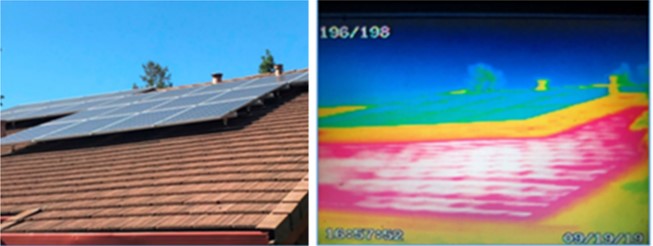
Similarly, if the walls or roof of the home are well-shaded by trees, bushes, or structures, then the impact of a cool roof or walls will be reduced. Cool surface technologies are most effective when a home is very exposed. For many homes, the walls are well-shaded while the roof is highly exposed to sunlight.
Overall, climate is the most important factor affecting how beneficial a cool roof or wall will be for a particular home. The other factors simply adjust how significant the benefit will be. If the home is located in Climates 1A through 3B, cool roofs and walls will likely make good sense regardless of the other factors mentioned. See the simplified decision tree at the end of this guide (Figure 14) for guidance in choosing whether or not to pursue cool surface technology for a specific home.
Additional Measures to Reduce Wall and Roof Heat Gain
There are a number of strategies that can be used instead of cool roofs or walls to reduce heat gain, or in conjunction with cool roofs and walls to reduce heat gain even more. In some instances, it makes sense to implement one or more of these measures instead of installing a cool roof or walls. In other situations, it makes sense to apply these measures alongside the application of cool roof or wall technology.
- Increasing insulation and air sealing. Increasing insulation and reducing infiltration has the great advantage that it is beneficial in both hot weather and cold weather. If a wall, attic, or roof is insulated below current code levels, increasing insulation should be strongly considered. Cool roofs and walls are not a substitute for proper insulation. In the case of a vented attic with HVAC equipment or ducting located in it, increasing insulation at the attic floor will not reduce the significant heat gains that occur through the HVAC arrangement. A cool roof can make very good sense in this situation regardless of how much attic insulation is installed. The following information guides provide links to guidance on various approaches to insulating and air sealing: “Air Sealing, Insulating, and Venting Attics and Roofs to Reduce Heat Gain” and “Air Sealing and Insulating Walls to Reduce Heat Gain.
- Increasing shading. Shading provides very similar benefits to those of cool roofs and walls, and is a highly effective strategy. However, most shading is only available for part of the day, while a cool surface will be effective all day long. See the “Landscaping to Reduce Cooling Load” guide for information on using trees and vegetation for solar control.
- Installing solar panels. Roof-mounted solar panels, when installed on a rack that provides space between the panels and the roof, are a form of roof shading that is effective all day long. However, solar panels typically only cover a portion of a home’s roof, while a cool roof will cover the entire home.
- Installing a radiant barrier. A radiant barrier installed in an attic will have a very similar effect to that of a cool roof. However, cool roofs help reduce the heat island effect, while radiant barriers do not. Which technology makes more sense for a home depends on the cost of materials and installation, the ease of installation, and whether or not the home is scheduled to be roofed or re-roofed. See the guide “Attic Radiant Barriers” for more information.
- Installing attic ventilation fans. Attic fans lower the air temperature in an attic, but a cool roof can be more effective because it will reduce the radiant temperature in the attic as well. Additionally, attic ventilation fans are generally not recommended due to several potential issues that they can cause. See the “Attic Ventilation Fans” information guide for more information.
- Installing a whole-house fan. Whole-house fans will reduce attic temperatures, but they should only be used when the air-conditioning is off. Also, like attic ventilation fans, they do not reduce heat gain through the ceiling as much as one might expect, due to the radiant transfer of heat from the roof to the attic floor. See the “Whole House Fans” guide for more information.
- Moving HVAC equipment and ductwork out of a vented attic and into conditioned space. This measure should be considered as a high priority in designing a new home and should be considered during system replacements in existing homes. Very significant energy losses in both summer and winter are associated with air handling units and/or ductwork being located in a vented, unconditioned attic.
Cool Roof Materials and Applications
Residential cool roofing materials come in a variety of product types, including asphalt shingles, clay or concrete tiles, coated metal, single-ply membranes, and asphaltic membranes.
All else being equal, lighter colored finishes outperform darker colored finishes on any of these materials, with white performing best. However, modern coatings that are reflective to the non-visible infrared portion of the solar energy spectrum can improve the performance of any color without changing its look. Dark colors with these coatings can have significantly higher SRIs than if uncoated, but they will usually not approach the high SRIs of white or very light colors.
Asphalt shingles usually have particularly low SRI ratings, especially when darker in color. Simply choosing white shingles can make a significant difference. A Florida utility study showed that choosing white shingles rather than dark shingles resulted in about a 4% reduction in measured space cooling at no extra cost to the home buyer or builder. Cool asphalt shingle roofing materials of various colors are available that perform far better than standard shingles. These products utilize granules that are covered in a reflective ceramic coating (Figure 11). The range of SRIs (3-yr aged) for cool asphalt shingles is generally about 20 to 35. Most or all asphalt shingle products with an SRI of 30 or higher are white in color. These values are still very low when compared to options available with metal, tile, and membrane roofing products.
Metal, tile, single-ply membrane, and asphaltic membrane roofs can perform extremely well as cool roof products (Figure 12). Three-year aged SRIs for white-colored finishes reach as high as 85 or 90 for metal roofs, above 60 and up to 90 for tile roofs, and well into the 90s for membrane roofs. Dark colors like brown and red can reach SRIs above 30 for metal roofs, above 35 or 40 for tile roofs, and about 5 to 20 for membrane roofs.
Cool options exist for an unfinished metal look as well. Standard galvanized unfinished metal roofing with no colored coating tends to perform very poorly, but unfinished metal roofs using a zinc-aluminum alloy can perform well (Parker 2002).
Roofs can accumulate moisture through condensation at night, and it is possible that cool roofs might be more susceptible to retaining moisture during daytime than dark roofs, especially in cooler and more humid climates. Tile and shingle roofs tend to be prone to algae or mold growth. Algae growth may be more visible on light-colored roofs, requiring cleaning every few years. Very smooth surfaces—such as painted metal roofs—tend to be more resistant to this issue. Irregular shapes, such as with barrel tile roofing, can increase potential algae growth. An impermeable underlayment membrane is an important feature of any shingle, tile, or metal roof to guard against condensation or other water that can accumulate beneath the roofing material.
When shingle roofs are nearing the end of their useful life, they can be painted with a cool elastomeric coating to extend their life and drastically increase the SRI. This practice can be risky, however, as it could void the roof warranty and lead to moisture damage, particularly in humid climates. Shingles have many edges, allowing moisture to migrate into crevices by capillary action. Typically, this moisture will evaporate away as the roof warms during the day, even with new cool roof shingles. Aftermarket coatings can have much higher SRI values than new cool shingles, however, so the roof may not warm enough to evaporate all of the moisture. This can potentially cause issues with algae or even material degradation.
Cool Wall Materials and Applications
Cool wall products include paints, coatings, stuccos, vinyl siding, fiber cement siding, painted wood composite siding, masonry, metal, and various films or fabrics. As with cool roofs, lighter colors tend to have higher SRIs, but numerous color options are available with improved performance using selective coatings. The simplest approach to a cool wall may simply be to choose white or light-colored paint finishes. This approach generally results in zero additional cost (Figure 13).
Cool wall claddings or paints can be most beneficial on poorly insulated walls, including concrete masonry unit (CMU) walls (which are often uninsulated in older homes). Homes that are two stories or more can generally benefit more from cool walls than one-story homes because taller walls usually have a smaller portion of the wall that is shaded by roof overhangs, vegetation, and adjacent structures.
The orientation of the walls has a significant effect on the impact of the cool surface. In the warmer climate zones, the east, south, and west-facing walls will show the most total annual savings from having higher solar reflectance. In cool climates (5 and above), increased solar reflectance on a south-facing wall will generally be detrimental overall due to increased heating needs – more detrimental than cool walls on the east, west, or north side of the home in these climates.
For an in-depth discussion of cool wall application guidelines and effects, see the California Energy Commission report "Solar-Reflective "Cool" Walls: Benefits, Technologies, and Implementation." Appendix P of this report provides specific guidelines. Section 4 of Appendix P presents the Cool Surface Savings Explorer, a spreadsheet tool that reports cool-roof and cool-wall benefits for buildings across California and the United States.
How to Select and Install a Cool Roof or Wall Product
- Determine the climate zone where the home is located based on the 2021 IECC. Use the map provided on the Climate tab of this guide.
- Use the decision tree below (Figure 14) to assess how significantly the home could benefit from a cool roof or walls. If it is determined that a cool roof or wall would be even a little bit beneficial, then it is worth seeking out higher reflectance materials or at least lighter color finishes, as these can often be obtained at no additional cost.
- Use the CRRC Rated Roof Products Directory and the CRRC Rated Wall Products Directory to aid the selection of the roofing, siding, or coating. Select products with the highest SRI that fits your budget, aesthetic, and material type requirements.
- Follow manufacturers’ instructions for installation. In general, installation will not differ from installation of standard roofing, siding, paint, or coatings.
Success
One of the best resources for any contractor, homeowner, or designer interested in cool roofs or walls is the Cool Roof Rating Council (CRRC) website. The site not only contains the Rated Roof Products Directory and the Rated Wall Products Directory, but also easy-to-understand practical information, frequently asked questions, printable brochures and fact sheets, code and compliance information, and useful links.
Any search for roofing or siding products should include checking solar reflectance and thermal emittance or SRI values in the CRRC product directories. There is no practical threshold for when a roof or wall can be considered cool, so simply looking for incremental increases in reflectance, emittance, or SRI within a particular product category can reduce energy costs for the owner of the home. Some jurisdictions have building code requirements for the radiative performance of roofing materials, so check the building code or check with the local building department prior to installing a new roof.
Climate
Use the map below to determine the IECC climate zone for your location.
Cool roofs reduce cooling energy but increase heating energy. The increase in heating energy is generally much less than one might think, however, as solar impact on roof and wall temperature is lower in winter than summer due to shorter days, lower intensity sunlight, lower solar angles, more cloudy days, and snow cover on roofs. Research has shown that in climate zones 1A up to 3B, cool roofs and walls are almost always beneficial. In climate zones 3C, 4A, and 4B, cool roofs and walls are usually beneficial, but the benefits are reduced due to the proportional increase in heating energy consumption. In climate zone 4C, cool roofs and walls have been shown to have nearly zero savings over the course of a year - the heating energy increases balance the cooling energy savings. In climate zones 5 and 6, cool roofs and walls are usually slightly beneficial for older air-conditioned homes in terms of total annual HVAC energy consumption. For climate zones 7 and higher, cool roofs and walls will generally have an overall energy penalty. With a warming climate, however, general recommendations could soon shift to include cooler climate zones.
Cool roofs and walls can mitigate the effects of extreme heat in all climates. If cool roofs and walls are desired to resist extreme heat in a cool climate, consider using cool technology on all surfaces except for south-facing walls, as these have the greatest effect on heating needs. This will balance the benefit of extreme heat resistance with the penalty in heating energy cost.
Training
Compliance
Compliance
The Codes, Programs, and Standards webpage on the Cool Roof Rating Council website provides a comprehensive list of relevant state, county, and city codes; model codes and standards; and voluntary programs for cool roofs and cool walls.
State or Local Codes
State or local building codes or homeowner associations may prescribe or require the use of cool roofs and/or cool exterior walls. Check with your local jurisdiction to determine any requirements related to the solar reflectance and thermal emittance properties of roofing or wall finishes. Many such requirements are geared toward reducing the localized heat island effect.
Retrofit
Retrofitting a home to take advantage of cool roof or wall technology is best done when the home is due for a re-roofing, roof coating, re-siding, or re-painting job. By utilizing these key points in time, cool surfaces can be installed for little or no additional cost. Initiating a cool roof or wall project that is otherwise not needed will generally not be cost effective.
More
More Info.
Access to some references may require purchase from the publisher. While we continually update our database, links may have changed since posting. Please contact our webmaster if you find broken links.
The following authors and organizations contributed to the content in this Guide.
